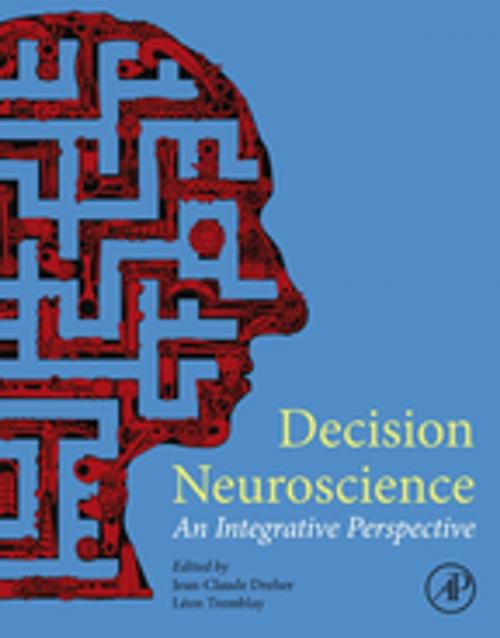Decision Neuroscience
An Integrative Perspective
Nonfiction, Health & Well Being, Medical, Medical Science, Physiology, Specialties, Internal Medicine, Neuroscience, Science & Nature, Science| Author: | ISBN: | 9780128053317 | |
| Publisher: | Elsevier Science | Publication: | September 27, 2016 |
| Imprint: | Academic Press | Language: | English |
| Author: | |
| ISBN: | 9780128053317 |
| Publisher: | Elsevier Science |
| Publication: | September 27, 2016 |
| Imprint: | Academic Press |
| Language: | English |
Decision Neuroscience addresses fundamental questions about how the brain makes perceptual, value-based, and more complex decisions in non-social and social contexts. This book presents compelling neuroimaging, electrophysiological, lesional, and neurocomputational models in combination with hormonal and genetic approaches, which have led to a clearer understanding of the neural mechanisms behind how the brain makes decisions. The five parts of the book address distinct but inter-related topics and are designed to serve both as classroom introductions to major subareas in decision neuroscience and as advanced syntheses of all that has been accomplished in the last decade.
Part I is devoted to anatomical, neurophysiological, pharmacological, and optogenetics animal studies on reinforcement-guided decision making, such as the representation of instructions, expectations, and outcomes; the updating of action values; and the evaluation process guiding choices between prospective rewards. Part II covers the topic of the neural representations of motivation, perceptual decision making, and value-based decision making in humans, combining neurcomputational models and brain imaging studies. Part III focuses on the rapidly developing field of social decision neuroscience, integrating recent mechanistic understanding of social decisions in both non-human primates and humans. Part IV covers clinical aspects involving disorders of decision making that link together basic research areas including systems, cognitive, and clinical neuroscience; this part examines dysfunctions of decision making in neurological and psychiatric disorders, such as Parkinson’s disease, schizophrenia, behavioral addictions, and focal brain lesions. Part V focuses on the roles of various hormones (cortisol, oxytocin, ghrelin/leptine) and genes that underlie inter-individual differences observed with stress, food choices, and social decision-making processes. The volume is essential reading for anyone interested in decision making neuroscience.
With contributions that are forward-looking assessments of the current and future issues faced by researchers, Decision Neuroscience is essential reading for anyone interested in decision-making neuroscience.
- Provides comprehensive coverage of approaches to studying individual and social decision neuroscience, including primate neurophysiology, brain imaging in healthy humans and in various disorders, and genetic and hormonal influences on decision making
- Covers multiple levels of analysis, from molecular mechanisms to neural-systems dynamics and computational models of how we make choices
- Discusses clinical implications of process dysfunctions, including schizophrenia, Parkinson’s disease, eating disorders, drug addiction, and pathological gambling
- Features chapters from top international researchers in the field and full-color presentation throughout with numerous illustrations to highlight key concepts
Decision Neuroscience addresses fundamental questions about how the brain makes perceptual, value-based, and more complex decisions in non-social and social contexts. This book presents compelling neuroimaging, electrophysiological, lesional, and neurocomputational models in combination with hormonal and genetic approaches, which have led to a clearer understanding of the neural mechanisms behind how the brain makes decisions. The five parts of the book address distinct but inter-related topics and are designed to serve both as classroom introductions to major subareas in decision neuroscience and as advanced syntheses of all that has been accomplished in the last decade.
Part I is devoted to anatomical, neurophysiological, pharmacological, and optogenetics animal studies on reinforcement-guided decision making, such as the representation of instructions, expectations, and outcomes; the updating of action values; and the evaluation process guiding choices between prospective rewards. Part II covers the topic of the neural representations of motivation, perceptual decision making, and value-based decision making in humans, combining neurcomputational models and brain imaging studies. Part III focuses on the rapidly developing field of social decision neuroscience, integrating recent mechanistic understanding of social decisions in both non-human primates and humans. Part IV covers clinical aspects involving disorders of decision making that link together basic research areas including systems, cognitive, and clinical neuroscience; this part examines dysfunctions of decision making in neurological and psychiatric disorders, such as Parkinson’s disease, schizophrenia, behavioral addictions, and focal brain lesions. Part V focuses on the roles of various hormones (cortisol, oxytocin, ghrelin/leptine) and genes that underlie inter-individual differences observed with stress, food choices, and social decision-making processes. The volume is essential reading for anyone interested in decision making neuroscience.
With contributions that are forward-looking assessments of the current and future issues faced by researchers, Decision Neuroscience is essential reading for anyone interested in decision-making neuroscience.
- Provides comprehensive coverage of approaches to studying individual and social decision neuroscience, including primate neurophysiology, brain imaging in healthy humans and in various disorders, and genetic and hormonal influences on decision making
- Covers multiple levels of analysis, from molecular mechanisms to neural-systems dynamics and computational models of how we make choices
- Discusses clinical implications of process dysfunctions, including schizophrenia, Parkinson’s disease, eating disorders, drug addiction, and pathological gambling
- Features chapters from top international researchers in the field and full-color presentation throughout with numerous illustrations to highlight key concepts















